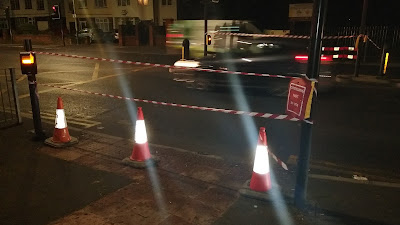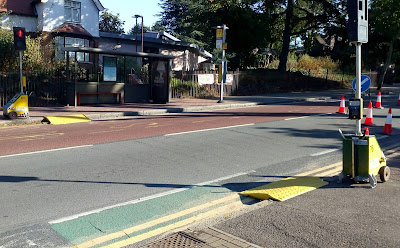If you want a measure of how we value people, then you can look at how we treat them when there is an emergency. Our response to an urgent situation can affect how quickly people can return to normal or at least a new normal.
I'm not actually going to talk about anything complicated here, the example is what we do when a pedestrian crossing is wiped out by driver. During my pootlings over the last few weeks, I came across some traffic signals which had been hit within a large signalised junction on a trunk road. The actual traffic signals which had been hit were part of a two-stage crossing of the road and the resulting emergency response was to simply close the crossing (below).
Fortunately in this case, the crossing has an opposite number on the other main arm of the junction and so at least people could divert their route. It would mean crossing way more stages, but at least there was a safe and accessible alternative.
A few days later, I happened on another crossing which had been closed after a signal pole had been wiped out (far side of the photograph below). The problem this time was there wasn't an alternative. This crossing was a single stage affair on a 30mph road. The time of day I was travelling allowed me to get round and find a gap in traffic, but at other parts of the day, some people would have no chance of crossing and the closest crossing is a narrow refuge 185 metres away where the road widens to two lanes in each direction.
Traffic signals are there to manage traffic (in the widest sense) and they are motoring infrastructure. They are used because people getting out of side roads wouldn't be able to find a gap and people walking (and cycling) need to be able to cross the road. The problem comes when this system goes wrong and the "weaker" flows (regardless of mode type) have to push their way into or across general traffic. In this dynamic, soft human beings come off badly and the slowest come off worst.
I baited Twitter with the proposition that in situations where a crossing is taken out of use, the urgent response should be to close the road to maintain the crossing until repairs are completed and general traffic is permitted to flow again. Obviously the suggestion didn't meet with universal acclaim, but why shouldn't that be the natural response?
Clearly, closing a trunk road for a couple of days is going to push traffic onto other streets and increase risk exposure elsewhere. There is a wider discussion around keeping a few people safe a day vs the disruptions to the lives of several thousands while the crossing is repaired and I think it is the kind of discussion we should be having. The logical outcome here applies to any road with traffic signals - if they were low traffic, then you wouldn't need crossings.
If you accept that these roads need to be capable of taking relatively high levels of motor traffic including HGVs and buses so that crossings are needed, then the response to those crossings being out of service requires much more thought. There is a discussion to be had about traffic volumes and the desirability of maintaining such a system, but I am talking about practical issues facing us this minute.
If we were to adopt a Sustainable Safety approach, then we would realise that giving these roads a traffic flow functionality means we need to protect users by dealing with the differences in mass and direction of movement, plus recognising that the overall design of these roads leads to a certain behaviour. If we extend this realisation to where crossings are out of use then this shapes our response.
From a motor traffic point of view, a set piece for a complete traffic signal failure at a junction on a trunk road would be to close right turns and cross traffic to immediately remove those risks from the system (see the photograph below, although the pedestrian crossings are also out of action). This response recognises that without signal control, the "weaker" movements cannot safely push through, especially as a design for high speeds will have people continuing through the junction at a speed inappropriate for the uncontrolled condition. The extension of this is to grade separate the junction which designs out the need for controls and therefore failure of the controls.
While having to follow a traffic diversion is annoying (and potentially move risk elsewhere), drivers are doing so in a comfortable and protected shell. Diverting by cycle is a bit more possible, but diverting on foot can mean very long walks to find somewhere to cross; plus people walking and cycling are using energy and directness is a key consideration, so people will try and cross anyway. Grade separation here is an option of course, but only if done right. It also takes time and money to achieve it and it's only really a trunk road option.
So, what can we do? Design is often my first go to response and maybe we could simply move the traffic signals out of harms way so they don't get wiped out in the first place? In some case this might be possible, but the layout of crossings and junctions means we need the signals where the right users are going to see them and some are going to be in the firing line. We've also options to tighten up geometry to slow drivers down, but if there is a signal opposite a sign road for example, it is probably going to be hit at some point.
Maybe we could protect the signals with bollards and barriers? That might stop the odd low speed knock, but in a higher speed situation, a system which protects the signal is probably going to kill or injure the vehicle occupant and our sustainable safety approach is to design for people to walk away, even from their own poor behaviour.
The appropriate solution here is to develop some detailed contingency plans to deal with a loss of a crossing as is often seen with the right turn bans I mentioned above. A local authority could go through it's inventory and risk assess each site. For example, a crossing near a school might need a more significant response than a crossing on a leisure route. Maintenance data should be reviewed to see if there are sites which tend to be hit more than others. This should spark a design review or at least raise a flag that there might need to be a higher level of response. I don't know for sure, but I would bet money that most of these collisions take place at night, but this could be useful data.
Once a risk assessment has taken place, then a series of stock responses can be formulated. For example, a crossing taken out on a trunk road where there is a school on one side of the road and lots of housing on the other side will need a swift response which might require temporary signals (below) to be deployed within 2-hours.
The supply side of temporary signals systems has become sophisticated in recent years and some very complex junction layouts can be run on temporary systems, although that obviously would take much more time to deploy. We can also specify retention sockets (below) for the signals which makes it easy to unplug signals and swap them out for new poles. If you think about it, there is a lot of investment in digging holes and pouring concrete to support signals and so being able to simply reuse foundations is both more efficient and easier to get back to a normal level of service.
There are other things we could do such as having pre-programmed arrangements in local signals networks to adjust timings. For example, we could increase all-red stages in a junction or increase the intergreens (time between traffic phases running) to give more informal crossing opportunities (although that's without crossing signals). We could also use junctions either side of the failure to hold traffic back to introduce longer gaps between platoons of traffic coming through.
As ever, this kind of thing needs people, time and money to develop and deploy. Having a signals contractor on call costs whether or not they are called out and putting plans into place then actually relies on having the staff and resources to deliver them and in many local authorities, both are in increasingly short supply.
These are just my anecdotes and thoughts, but I think my original point stands in how we value people and why it is lacking. Your thoughts and experiences are encouraged and welcomed!






I agree with all this. It will also be another of those choices where closing the crossing will disproportionally effect women, children and the elderly, given more drivers will be men and in an urban area probably better off people over the poor. Levelling up means not closing crossings down.
ReplyDelete